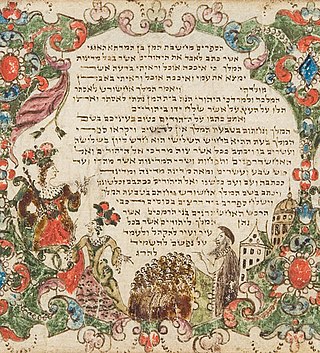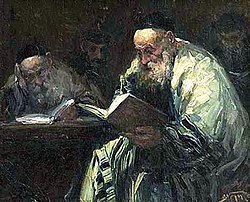
The Book of Esther, also known in Hebrew as "the Scroll", is a book in the third section of the Hebrew Bible. It is one of the Five Scrolls in the Hebrew Bible and later became part of the Christian Old Testament. The book relates the story of a Jewish woman in Persia, born as Hadassah but known as Esther, who becomes queen of Persia and thwarts a genocide of her people.

Esther, originally Hadassah, is the eponymous heroine of the Book of Esther in the Hebrew Bible. According to the biblical narrative, which is set in the Achaemenid Empire, the Persian king Ahasuerus falls in love with Esther and marries her. His grand vizier Haman is offended by Esther's cousin and guardian Mordecai because of his refusal to bow before him; bowing in front of another person was a prominent gesture of respect in Persian society, but deemed unacceptable by Mordecai, who believes that a Jew should only express submissiveness to God. Consequently, Haman plots to have all of Persia's Jews killed, and eventually convinces Ahasuerus to permit him to do so. However, Esther foils the plan by revealing and decrying Haman's plans to Ahasuerus, who then has Haman executed and grants permission to the Jews to take up arms against their enemies; Esther is hailed for her courage and for working to save the Jewish nation from eradication.

Agag is a Northwest Semitic name or title applied to a biblical king. It has been suggested that "Agag" was a dynastic name of the kings of Amalek, just as Pharaoh was used as a dynastic name for the ancient Egyptians. The etymology is uncertain, according to John L. McKenzie (1995), while Cox (1884) suggested "High."

Mordecai is one of the main personalities in the Book of Esther in the Hebrew Bible. He is described in Tanna Devei Eliyahu as being the son of Jair, of the tribe of Benjamin and member of the Sanhedrin. Mordecai was also the cousin and guardian of Esther, who became queen of Persia under the reign of Ahasuerus. Mordecai's loyalty and bravery are highlighted in the story as he helps Esther foil the plot of Haman, the king's Vizier, to exterminate the Jewish people. His story is celebrated in the Jewish holiday of Purim, which commemorates his victory. However, since the 1890s, some academics have suggested that Purim originated from a Babylonian or Persian myth or festival, noting the lack of overt religious elements in the story, with a hypothesis that “[The Book of] Esther [is] a historicized myth or ritual”.

Purim is a Jewish holiday that commemorates the saving of the Jewish people from annihilation at the hands of an official of the Achaemenid Empire named Haman, as it is recounted in the Book of Esther.

Vashti was a queen of Persia and the first wife of Persian king Ahasuerus in the Book of Esther, a book included within the Tanakh and the Old Testament which is read on the Jewish holiday of Purim. She was either executed or banished for her refusal to appear at the king's banquet to show her beauty as Ahasuerus wished, and was succeeded as queen by Esther, a Jew. That refusal might be better understood via the Jewish tradition that she was ordered to appear naked. In the Midrash, Vashti is described as wicked and vain; she is viewed as an independent-minded heroine in feminist theological interpretations of the Purim story.

Haman is the main antagonist in the Book of Esther, who according to the Hebrew Bible was an official in the court of the Persian empire under King Ahasuerus, commonly identified as Xerxes I but traditionally equated with Artaxerxes I or Artaxerxes II. As his epithet Agagite indicates, Haman was a descendant of Agag, the king of the Amalekites. Some commentators interpret this descent to be symbolic, due to his similar personality.
The term Agagite is used in the Book of Esther as a description of Haman. The term is understood to be an ethnonym although nothing is known with certainty about the people designated by the name.

Seder Olam Rabbah is a 2nd-century CE Hebrew language chronology detailing the dates of biblical events from creation to Alexander the Great's conquest of Persia. It adds no stories beyond what is in the biblical text, and addresses such questions as the age of Isaac at his binding and the number of years that Joshua led the Israelites. Tradition considers it to have been written about 160 CE by Jose ben Halafta, but it was probably also supplemented and edited at a later period.

Allusions in rabbinic literature to the Biblical character Job, the object of sufferings and tribulations in the Book of Job, contain various expansions, elaborations and inferences beyond what is presented in the text of the Bible itself.

Esther was the chief character in the Book of Esther. She is counted among the prophetesses of Israel. Allusions in rabbinic literature to the Biblical story of Esther contain various expansions, elaborations and inferences beyond the text presented in the book of the Bible.
Zeresh was the wife of Haman the Agagite who is mentioned in the Hebrew Bible in the Book of Esther.
Rabbi Aha was a rabbi of the Land of Israel, of the fourth century.

Esther, also known as The Bible: Esther, is a 1999 American-Italian-German television film based on the Book of Esther, directed by Raffaele Mertes and starring Louise Lombard as Queen Esther, F. Murray Abraham as Mordechai, Jürgen Prochnow as Haman, Thomas Kretschmann as King Achashverosh and Ornella Muti as Vashti.
Rabbi Isaac Nappaha, or Isaac the smith, was a rabbi of the 3rd-4th centuries who lived in the Galilee.

One Night with the King is a 2006 American religious epic film produced by Matt Crouch and Laurie Crouch of Gener8Xion Entertainment, directed by Michael O. Sajbel, and starring Peter O'Toole, Tiffany Dupont, John Rhys-Davies, and Luke Goss.

The Book of Esther is a 2013 American biblical-drama film directed by David A. R. White and starring Jen Lilley as Esther. The film portrays a Jewish girl, Esther, who is chosen as the new queen consort to King Xerxes I of Persia and her efforts to stop evil Lord Haman's plot to exterminate the Jews. The film is loosely based on the biblical tale of the Book of Esther. It was released on June 11, 2013, in the United States as a direct-to-TV special.

Esther 3 is the third chapter of the Book of Esther in the Hebrew Bible or the Old Testament of the Christian Bible. The author of the book is unknown and modern scholars have established that the final stage of the Hebrew text would have been formed by the second century BCE. Chapters 3 to 8 contain the nine scenes that form the complication in the book. This chapter introduces Haman the Agagite, who is linked by his genealogy to King Agag, the enemy of Israel's King Saul, from whose father, Kish, Mordecai was descended. The king Ahasuerus elevated Haman to a high position in the court, and ordered everyone to bow down to him, but Mordecai refuses to do so to Haman, which is connected to Mordecai's Jewish identity (as Jews would only bow down to worship their own God ; this indirectly introduced the religious dimension of the story. Haman reacted by a vast plan to destroy not simply Mordecai, but his entire people, getting the approval from the king to arrange for a particular date of genocide, selected by casting a lot, or pur to fall on the thirteenth day of the twelfth month, Adar. The chapter ends with the confused reaction of the whole city of Susa due to the decree.

Esther 8 is the eighth chapter of the Book of Esther in the Hebrew Bible or the Old Testament of the Christian Bible, The author of the book is unknown and modern scholars have established that the final stage of the Hebrew text would have been formed by the second century BCE. Chapters 3 to 8 contain the nine scenes that form the complication in the book. This chapter contains the effort to deal with the irreversible decree against the Jews now that Haman is dead and Mordecai is elevated to the position of prime minister.

Esther 9 is the ninth chapter of the Book of Esther in the Hebrew Bible or the Old Testament of the Christian Bible, The author of the book is unknown and modern scholars have established that the final stage of the Hebrew text would have been formed by the second century BCE. Chapters 9 to 10 contain the resolution of the stories in the book. This chapter records the events on the thirteenth and fourteenth of Adar and the institution of the Purim festival after the Jews overcome their enemies.














